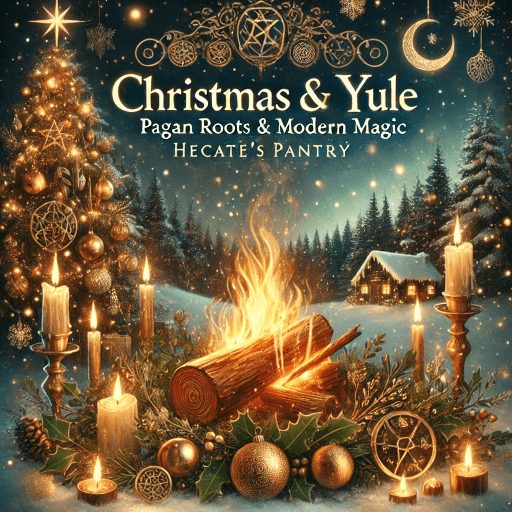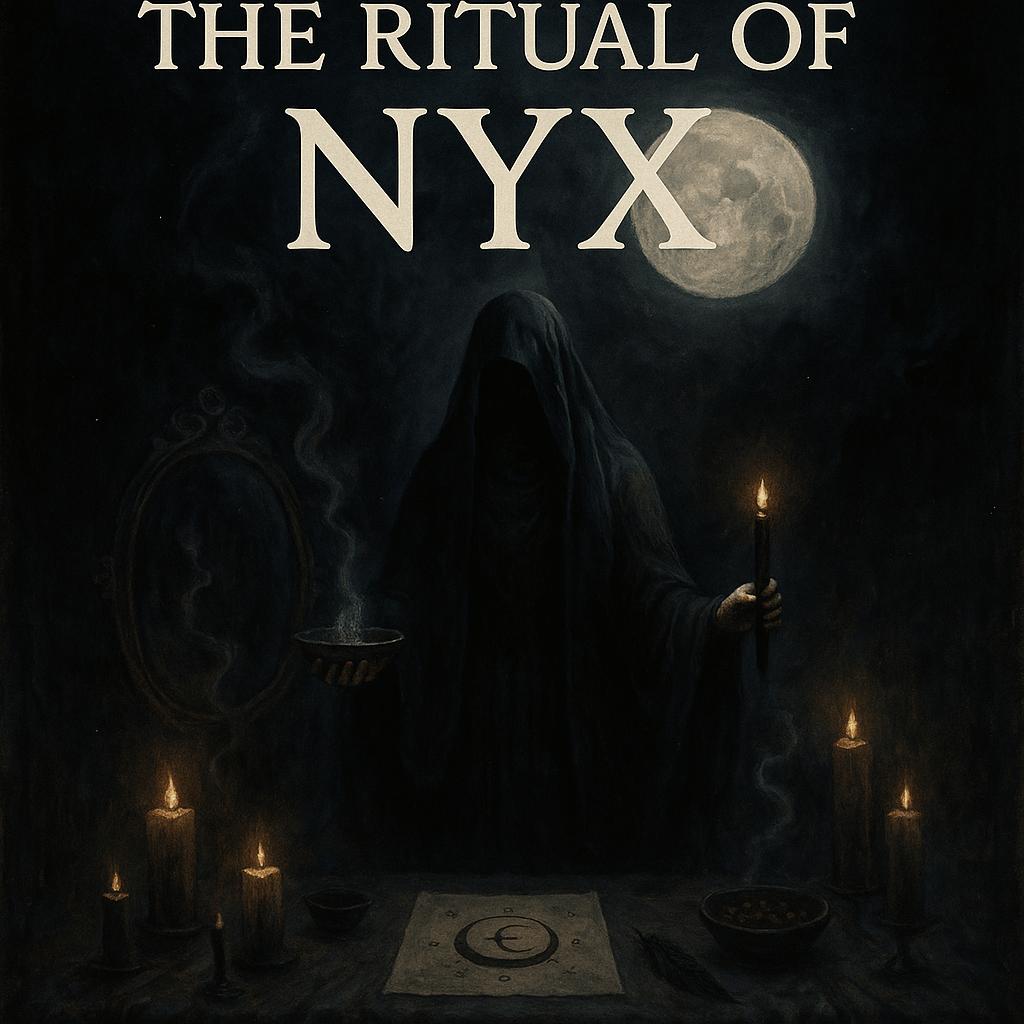Your cart is currently empty!

Christmas and Yule: A Tale of Two Winter Celebrations
Winter is a season of enchantment, a time when the days grow short, the nights long, and the air crisp with mystery. Among its most beloved holidays are Christmas and Yule, two celebrations that, though originating in vastly different contexts, intertwine in ways both surprising and delightful. Christmas, with its carols, bright lights, and nativity scenes, is a cornerstone of Christian tradition, while Yule harks back to ancient pagan customs rooted in the rhythms of nature and the cycles of the sun.
As we delve into their histories, rituals, and evolving traditions, we’ll uncover the deep connections between the two, exploring how pagan roots influenced both holidays. Along the way, we’ll discover practices that blend whimsy with reverence, examples of prayers and rituals, and the enduring charm that binds these winter celebrations together.
The Origins: The Story of Two Holidays
Christmas: A Christian Celebration with Ancient Influences
Christmas, celebrated on December 25th, is widely regarded as the commemoration of Jesus Christ’s birth. However, the Bible provides no specific date for Christ’s nativity. Scholars believe the early Christian Church chose December 25 to align with pre-existing pagan festivals such as Saturnalia and Sol Invictus, both of which celebrated themes of light and renewal. By co-opting these popular pagan festivities, early Christians aimed to ease the transition for converts and reinforce their own theological themes of salvation and divine light.
Pagan Roots of Christmas
- Saturnalia: This week-long Roman festival, honoring Saturn, the god of agriculture, was a time of merriment, feasting, and gift-giving. It culminated around the Winter Solstice, symbolizing the renewal of light.
- Sol Invictus: Also known as the “Unconquered Sun,” this celebration marked the sun’s gradual return after the darkest day of the year. The metaphor of the sun’s triumph over darkness easily paralleled the Christian belief in Christ as the “light of the world.”
- Evergreens and Decorations: Romans decorated their homes with greenery during Saturnalia, a tradition carried into Christmas with wreaths and later the Christmas tree.
By combining these pagan elements with Christian theology, Christmas became a hybrid holiday, its dual nature reflected in its sacred and secular celebrations.
Yule: A Festival of the Earth and Sky
Yule, celebrated on or around the Winter Solstice (December 21), originated among the Norse and Germanic peoples as a deeply spiritual and nature-centered festival. Marking the longest night of the year, Yule celebrated the turning point when the sun began its gradual return. For ancient pagans, this renewal of light was sacred, symbolizing hope, resilience, and the cycles of life.
Core Beliefs and Practices of Yule
- The Yule Log: A massive log, often oak, was ceremonially burned in the hearth, symbolizing the sun’s power and bringing blessings for the year ahead. Families would keep a piece of the log to protect their homes until the next Yule.
- Nature and Evergreens: Holly, ivy, mistletoe, and pine were revered as symbols of eternal life, their green vibrance a reminder of the earth’s vitality even in winter’s depths.
- The Wild Hunt: This folkloric motif, featuring ghostly riders led by the god Odin, represented spiritual transformation and the thin veil between the mortal world and the divine.
Unlike Christmas, which developed into a primarily theological celebration, Yule remained a festival of the natural world, honoring the rhythms of earth and sky.
Contrasting Themes: The Sacred and the Seasonal
While both Christmas and Yule celebrate themes of light and renewal, their interpretations differ. Christmas focuses on the divine—light as a symbol of God’s love and salvation through Christ. Yule, on the other hand, centers on the natural—light as the returning sun and the promise of nature’s rebirth.
Both holidays embrace a sense of hope during winter’s darkness, but their paths diverge when it comes to how this hope is expressed. Christmas looks upward, to divine intervention, while Yule looks around, to the rhythms of the earth.
Symbols and Practices: Echoes of Pagan Tradition
The Christmas Tree and the Yule Tree
The modern Christmas tree, with its twinkling lights and ornaments, is one of the most recognizable symbols of the holiday. Its origins lie in Yule, where pagans decorated trees with natural ornaments like fruits, nuts, and ribbons to honor the spirits of the forest. Early Christians adapted the tradition, associating it with the paradise tree from the Garden of Eden.
Candles and Light
Both holidays use candles as powerful symbols of light:
- In Yule, candles represent the sun’s rebirth, often placed on altars or lit during rituals.
- In Christmas, candles shine in Advent wreaths and during Midnight Mass, symbolizing Christ as the light of the world.
Festive Foods: Feasting Through the Ages
Feasting has always been central to winter celebrations, a way to gather warmth, community, and nourishment in the coldest months.
Yule Feasts
Yule feasts often featured roasted boar, symbolizing the Norse god Freyr, who governed fertility and prosperity. Mead, a honey-based drink, was a staple, and spiced cakes were prepared as offerings to deities or spirits.
Christmas Feasts
Christmas dinners share similarities, with roasted meats, sweet treats, and rich beverages. The famed Christmas pudding, with its blend of spices and fruits, is a descendant of older solstice recipes.
Both holidays embrace food as more than sustenance—feasts are acts of celebration, offerings of gratitude, and rituals of connection.
Rituals and Prayers: Invoking the Sacred
Christmas Prayers and Blessings
Prayers during Christmas emphasize love, peace, and divine blessings.
Example Prayer for Christmas Eve:
“Dear Lord, on this holy night, we give thanks for the gift of Your Son, the light of the world. Bless our family and guide us to live with compassion and hope, remembering Your love in every moment. Amen.”
Modern traditions like Midnight Mass and Advent candle-lighting provide sacred spaces for reflection and joy.
Yule Rituals and Invocations
Ancient Yule rituals focused on aligning with the natural world, often involving fire, meditation, and offerings. Many modern pagans and Wiccans continue these traditions today.
Example Ritual: The Yule Log Blessing
- Choose a log (oak is traditional) and carve or paint it with symbols of the sun or intentions for the year ahead.
- Sprinkle the log with salt, herbs, or mead, and recite:
“Blessed Yule, sacred fire, ignite within us all desire.
Bring us warmth and bring us light, through the longest, darkest night.” - Burn the log in your hearth or fireplace, visualizing your blessings for the year.
Solstice Meditation Example: Sit quietly on the longest night, holding a candle. Reflect on the past year’s challenges and triumphs, then light the candle, whispering, “With this flame, I welcome the sun and all the light it brings.”
The Modern Blend: Christmas and Yule Today
For many, the lines between Christmas and Yule have blurred. Those who observe both find creative ways to merge traditions:
- Decorating a Christmas tree with natural Yule-inspired ornaments like pinecones and dried fruits.
- Incorporating solstice meditations into Advent reflections.
- Hosting feasts that honor both the sacred and the seasonal, with dishes from each tradition.
Even Santa Claus carries echoes of Yule’s past: Odin, with his white beard, flying horse Sleipnir, and penchant for gift-giving, is often seen as a precursor to the jolly figure we know today.
Stories and Songs of the Season
Songs and stories hold a special magic during Christmas and Yule.
Christmas Songs
Carols like “Silent Night” and “O Come, All Ye Faithful” celebrate the spiritual heart of Christmas. Meanwhile, playful tunes like “Deck the Halls” and “Jingle Bells” reflect the seasonal cheer inherited from pagan revelries.
Yule Songs
Pagans honor the solstice with chants and folk songs:
“The wheel has turned, the fire burns bright,
We celebrate the longest night.
The sun returns, its rays shall glow,
Blessed Yule, to all below!”
Conclusion: A Shared Spirit of Joy and Renewal
Christmas and Yule, though distinct in origin, share an unshakable bond. Both remind us to celebrate light in the darkness, the warmth of community, and the enduring cycles of life. Whether through the glow of a Christmas tree or the blaze of a Yule log, these winter holidays invite us to reflect, rejoice, and revel in the magic of the season.
By embracing their shared history and unique beauty, we can craft a celebration that honors tradition while creating new memories to carry forward. Blessed Yule and Merry Christmas to all!
References
- Hutton, Ronald. The Stations of the Sun: A History of the Ritual Year in Britain. Oxford University Press, 1996.
- Miles, Clement A. Christmas in Ritual and Tradition, Christian and Pagan. T. Fisher Unwin, 1912.
- Cunningham, Scott. Wicca: A Guide for the Solitary Practitioner. Llewellyn Publications, 1988.
- Kelley, Aidan A. Crafting the Pagan Path: A Guide to Personal Practice. Llewellyn Worldwide, 2014.
- Frazer, James. The Golden Bough: A Study in Magic and Religion. Macmillan, 1922.






